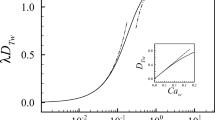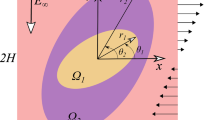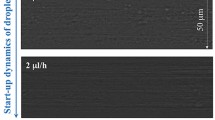Abstract
A numerical simulation scheme based on a three-dimensional boundary integral method is used for the purpose of estimating the macroscopic flow from the microscale drop deformation for emulsions of high viscosity ratio under steady, oscillatory shear, and extensional flows. The effects of drop deformation and shear rate are examined for moderate and high viscosity ratio. The accuracy and convergence of the numerical simulations is illustrated by comparing drop deformation and rheology with experimental observations and an asymptotic theory based on a second-order small deformation theory also developed in this work. We also examine an emulsion undergoing a pure extensional flow and an extensional viscosity of the emulsion is computed by the theory and the numerical simulations. In addition, we also explore regimes of linear and nonlinear viscoelasticity when the emulsion is subjected to oscillatory shear for different viscosity ratio. Emulsion Fourier modes are examined for two different viscosity ratio. For a more concentrate emulsion with an unit viscosity ratio, a static shear elastic modulus is computed as a function of drop volume fraction and compared with experimental data. The numerical simulation results are validated against theory and experimental observation of drops in shear and extensional flows. A very good agreement is observed for moderate and high viscosity ratio. The regime of emulsions with relatively high viscosity ratios has not been much explored in the current theoretical and experimental literature. The boundary integral numerical simulations developed in this work has the ability to predict what we expect on the behavior of emulsion with moderate and high viscosity ratio.



















Similar content being viewed by others
References
Barthés-Biesel D, Acrivos A (1973a) Deformation and burst of a liquid droplet freely suspended in a linear field. J Fluid Mech 61:1–21
Barthés-Biesel D, Acrivos A (1973b) The rheology of suspensions and its relation to phenomenological theories for non-newtonian fluids. Int J Multiphase Flow 1:1–24
Batchelor GK (1970) The stress in a suspension of force-free particles. J Fluid Mech 41:545–570
Bazhlekov IB, Anderson PD, Meijer HEH (2004) Nonsingular boundary integral method for deformable drops in viscous flows. Phys Fluids 16:1064–1081
Beenakker CWJ (1986) Ewald sum of rotne-prager tensor. J Chem Phys 85:1581–1582
Bentley BJ, Leal LG (1986) An experimental investigation of drop deformation and breakup in steady two-dimensional linear flows. J Fluid Mech 167:241–283
Bird RB, Armstrong RC, Hassager O (1987) Dynamic of polymeric liquids, vol 1 & 2. Wiley-Interscience
Clausse D, Gomez F, Dalmazzone C, Noik C (2005) A method for the characterization of emulsions, thermogranulometry: application to water-in-crude oil emulsion. J Colloid Interface Sci 287:694–703
Cristini V, Blawzdziewicz J, Loewenberg M (1998) Drop breakup in three-dimensional viscous flows. Phys Fluids 10:1781–1783
Cristini V, Blawzdziewicz J, Loewenberg M (2001) An adaptive mesh algorithm for evolving surface: simulations of drop breakup and coalescence. J Comput Phys 168:445–463
Cunha FR, Almeida MHP, Loewenberg M (2003a) Direct numerical simulations of emulsion flows. J Braz Soc Mech Sci Eng 25:30–40
Cunha FR, Albernaz DL (2013) Oscillatory motion of a spherical bubble in a non-newtonian fluid. J Non-Newtonian Fluid Mech 191:35–44
Cunha FR, Hinch EJ (1996) Shear-induced dispersion in a dilute suspension of rough spheres. J Fluid Mech 309:211–223
Cunha FR, Loewenberg M (2003) A study of emulsion expansion by a boundary integral method. Mech Res Commun 30:639–649
Cunha FR, Sousa AJ, Loewenberg M (2003) A mathematical formulation of the boundary integral equations for a compressible stokes flow. Comput Appl Math 22:53–73
Derkach SR (2009) Rheology of emulsions. Adv Colloid Interface Sci 151:1–23
Finlayson BA (1972) The Method of Weighted Residuals and Variational Principles—with Application in Fluid Mechanics and Mass Transfer. Academic Press, New York
Frankel NA, Acrivos A (1970) The constitutive equation for a dilute emulsion. J Fluid Mech 44:65–78
Guido S (2011) Shear-induced droplet deformation: Effects of confined geometry and viscoelasticity. Curr Opin Colloid Interface Sci 16:61–70
Guido S, Grosso M, Maffettone PL (2004) Newtonian drop in a newtonian matrix subjected to large amplitude oscillatory shear flows. Rheol Acta 43:575–583
Hinch EJ (1991) Perturbation methods. Cambridge University Press
Kim S, Karrila S (1991) Microhydrodynamics: principles and selected applications. Butterwrth-Heinemann
Kraynik AM, Reinelt DA, Princen HM (1991) The nonlinear elastic behavior of polydisperse hexagonal foams and concentrated emulsions. J Rheol 35:1235–1253
Kwak S, Pozrikidis C (1998) Adaptive triangulation of evolving, closed, or open surfaces by the advancing-front method. J Comput Phys 145:61–88
Ladyzheskaya OA (1969) The mathematical theory of viscous inclompressible flow, New York
Landau LD, Lifshitz EM (1987) Fluid Mechanics, Course of Theoretical Physics, 2nd
Li X, Zhou H, Pozrikidis C (1995) A numerical study of the shearing motion of emulsions and foams. J Fluid Mech 286:379–404
Loewenberg M, Hinch EJ (1996) Numerical simulations of a concentrated emulsion in shear flow. J Fluid Mech 321:395–419
Loewenberg M, Hinch EJ (1997) Collision of two deformable drops in shear flow. J Fluid Mech 338:229–315
Manga M, Stone HA (1996) Buoyancy-driven interactions between two deformable viscous drops. J Fluid Mech 256:647–683
Mason TG, Lacasse MD, Grest SG, Levine D, Bibette J, Weitz DA (1997) Osmotic pressure and viscoelasticity shear moduli of concentrated emulsions. Phys Rev E 56:3150–3166
Mo G, Sangani AS (1994) A method for computing stokes flow interactions among spherical objects and its application to suspensions of drops and porous particles. Phys Fluids 6:1637–1652
Mokhtarian F, Khalili N, Yuen P (2001) Curvature computation on free-form 3-d meshes at multiple scales. Comput Vis Image Underst 83:118–139
Nemer M, Chen X, Papadopoulos DH, Blawzdziewicz J, Loewenberg M (2004) Hindered and enhanced coalescence of drops in stokes flows. Phy Rev Lett 92
Oliveira T. F (2007) Microhydrodynamics and Rheology of Emulsions (in portuguese ). Ph.D. thesis Pontificia Universidade Catolica do Rio de Janeiro
Oliveira TF, Cunha FR (2011) A theoretical description of a dilute emulsion of very viscous drops undergoing unsteady simple shear. J Fluids Eng 133(10):101208
Pal R (2001) Shear viscosity behavior of emulsions of two immiscible liquids. J Colloid Interface Sci 225:359–366
Pal R (2011) Rheology of simple and multiple emulsions. Curr Opin Colloid Interface Sci 16:41–60
Pozrikidis C (1992) Boundary integral and singularity methods for linearized viscous flow. Cambridge University Press
Pozrikidis C (1994) Motion and deformation of liquid drops, and the rheology of dilute emulsions in simple shear flow. Comput Fluids 23/2:251–278
Pozrikidis C (1996) Computation of periodic green’s functions of stokes flow. J Eng Math 30:79–96
Pozrikidis C (2003) Numerical simulation of the flow-induced deformation of red blood cells. Ann Biomed Eng 31:1194–1205
Rallison JM (1980) A note on the time dependent deformation of a viscous drop which is almost spherical. J Fluid Mech 98:625–633
Rallison JM (1981) A numerical study of the deformation and burst of a viscous drop in general shear flows. J Fluid Mech 109:465–482
Rallison JM (1984) The deformation of small viscous drops and bubbles in shear flows. Ann Rev Fluid Mech 16:45–66
Rallison JM, Acrivos A (1978) A numerical study of the deformation and burst of a viscous drop in an extensional flow. J Fluid Mech 89:191–200
Reinelt DA, Kraynik AM (1993) Large elastic deformations of three-dimensional foams and highly concentrated emulsions. J Colloid Int Sci 159:460–470
Schowalter WR, Chaffey CE, Brenner H (1968) Rheological behavior of a dilute emulsion. J Colloid Int Sci 26:152–160
Skotheim JM, Secomb TW (2007) Red blood cells and other nonspherical capsules in shear flow: Oscillatory dynamics and the tank-treading-to-tumbling transition. Phys Rev Lett 98:078301
Stone HA (1994) Dynamics of drop deformation and breakup in viscous fluids. Ann Rev Fluid Mech 26:65–102
Sui Y, Chew YT, Roy P, Cheng YP, Low HT (2008) Dynamic motion of red blood cells in simple shear flow. Phys Fluids 20:112106
Tanzosh J, Manga M, Stone HA (1992) Boundary integral methods for viscous free-boundary problems: deformation of single and multiple fluid-fluid interfaces. In: Brebbia CA, Ingber MS (eds) Proceedings of Boundary Element Technologies VII. Computational Mechanics Publications, Albuquerque, New Mexico, pp 19–39
Taylor GI (1934) The formation of emulsions in definable fields of flow. Proc R Soc London Ser A 146:501–523
Torza S, Cox RG, Mason SG (1972) Particle motion in sheared suspensions. J Colloidal Interface Sci 38:395–411
Vlahovska P (2011) On the rheology of a dilute emulsion in a uniform electric field. J Fluid Mech 670:481–503
Vlahovska P, Blawzdziewicz J, Loewenberg M (2002) Nonlinear rheology of a dilute emulsion of surfactant-covered spherical drops in time-dependent flows. J Fluid Mech 463:1–24
Vlahovska P, Blawzdziewicz J, Loewenberg M, 2009 Small-deformation theory for a surfactant-covered drop in linear flows. J Fluid Mech 624:293–337
Wetzel ED, Tucker C (2001) Droplet deformation in dispersions with unequal viscosities and zero interfacial tension. J Fluid Mech 426:199–228
Xu QY, Nakajima M, Binks BP (2005) Preparation of particle-stabilized oil-in-water emulsions with the microchannel emulsification method. Colloids Surf A 262:94–100
Youngren GK, Acrivos A (1975) Stokes flow past a particle of arbitrary shape: a numerical method of solution. J Fluid Mech 69:377–403
Zhou H, Pozrikidis C (1993) The flow of ordered and random suspensions of two-dimensional drops in channel. J Fluid Mech 255:103–127
Zinchenko AZ, Davis RH (2002) Shear flow of highly concentrated emulsions of deformable drops by numerical simulations. J Fluid Mech 455:21–62
Zinchenko AZ, Davis RH (2003) Large-scale simulations of concentrated emulsion flows. Philos Trans Royal Soc Lond A 361:813–845
Zinchenko AZ, Rother MA, Davis RH (1997) A novel boundary-integral algorithm for viscous interaction of deformable drops. Phys Fluids 9:1493–1511
Acknowledgments
We would like to thank Professor Michael Loewenberg (Yale University - USA) for many helps with elucidative discussions on Boundary Integral Method and with the theory of high viscosity ratio emulsions. The authors are grateful to the CNPq-Brazil and CAPES-Brazil for their generous support to this work.
Author information
Authors and Affiliations
Corresponding author
Appendix
Appendix
Periodic green’s function
The kernel functions \({\boldsymbol {\mathcal {G}}}^{P}\) and \({\boldsymbol {\mathcal {T}}}^{P}\) are the periodic stokeslet and stresslet in a periodic lattice defined as an Ewald-summation on the reciprocal lattice of image points (Beenakker 1986).
These tensors include terms with respect to the lattice sums in real space r, \(({\boldsymbol {\mathcal {G}}}_{1},\textbf {H}_{1})\) and the reciprocal space k \(({\boldsymbol {\mathcal {G}}}_{2},\textbf {H}_{2})\). Here
where
Here, α(r), β(r), γ(r) are mobility functions defined in Beenakker (1986). It is straightforward to show that the above boundary integral formulation is consistent with the expression of the threedimensional boundary integral given by Rallison and Acrivos (1978) for a viscous drop under a general shear in the free space. For this cases, the kernel functions \({\boldsymbol {\mathcal {G}}}^{P}\) and \({\boldsymbol {\mathcal {T}}}^{P}\) reduce to the Greenś functions of the free space, being
Rights and permissions
About this article
Cite this article
Oliveira, T.F., Cunha, F.R. Emulsion rheology for steady and oscillatory shear flows at moderate and high viscosity ratio. Rheol Acta 54, 951–971 (2015). https://doi.org/10.1007/s00397-015-0885-4
Received:
Revised:
Accepted:
Published:
Issue Date:
DOI: https://doi.org/10.1007/s00397-015-0885-4




